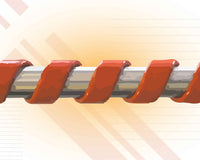Mobile home owners, look out below — the most vulnerable part of your trailer is often its underside. And if you’re not taking the necessary steps to protect it, you’re undermining your investment. Skirting is key to this effort, forming a barrier around your mobile home, between the trailer floor and the ground. It helps make your home look like your own and prevents critters from settling in and making your home their own. More importantly, it conceals your mobile home’s support structure (underpinning), wiring, and pipes while also helping to insulate and ventilate. In some states, going skirting-less is even against code.
Learning how to install mobile home skirting will ultimately benefit you in the form of decreased energy bills, pest control fees, and maintenance costs, all while keeping you in compliance with your local municipal and/or park regulations.
What you need to get started
Aside from the skirting material itself (typically vinyl, but many other materials can serve as skirting), you’ll need tools for:
- Measurement and alignment: tape measure, level/plumb bob, wooden stakes, and chalk line
- Cutting and resizing the skirting panels: tin snips and utility knife
- Affixing and securing to the frame: hammer, ground spikes and nails
A typical mobile home skirting package will consist of some combination of:
- Skirting panels : covers the vertical space between the ground and trailer floor)
- Ground tracks/rails (U-channel): the bottom perimeter of the skirting with a space for the panels to lock into
- Top back rail (J-channel): The top guide for the skirting panels — wraps around the bottom of the trailer (forming a J shape) and is affixed in place.
- Top front rail (trim): interlocks with the top back to secure everything in place and complete a cohesive look.
- Skirt guards: Protects the bottom of your skirting from the ravages of weed whackers and lawnmowers.
How much mobile home skirting do I need?
It is important to acquire all the mobile home skirting you need in a single purchase, as slight variations in manufacturing conditions or the future availability of supplies could throw off your entire project. It's recommended you buy a little more than you need, to give yourself some margin for error.
To calculate how much skirting you need, add together the two widths and lengths of your home, plus the three sides of any porches or decks that may be jutting out from the trailer. Next, determine the average height of your home by taking measurements between the bottom of the trailer and the ground at each of the corners and at the middle of each of the longer sides. Divide the sum of those measurements by six.
Mobile home skirting installation procedure
1. Preliminary steps
First, ensure levelness of ground around the trailer. Use wooden stakes to define the corners of the perimeter, using your level or plumb bob to make they are aligned with the bottom of the mobile home. Snap a chalk line to draw the perimeter between the corner stakes.
2. Anchor the bottom rail to the ground
Clear the installation area of obstructions or debris, and position the back leg of the bottom rail just inside the chalk line you laid earlier. Then using ground spikes, anchor the bottom rail to the ground. The inner face of the rail should be parallel with the bottom edge of the mobile home along the perimeter. The U-channel is where we will insert our skirting panels.
3. Affixing the top back rail to the home
Using the chalk line to keep things straight and even, nail or screw the top back rail almost totally into place, leaving 1/16” between the screw or nail head and the surface of the rail. This allows for thermal expansion. Leave ½” between each back rail section for the same purpose.
4. Insert skirting panels
Insert the mobile home skirting panels into the U-channel of the bottom rail, using tin snips cut to fit. Use a square or measuring tape to mark off where the cuts must be made to ensure accuracy. Be sure that there is 1 foot of venting for every 150 feet of flooring; you want slits or holes that are big enough to facilitate airflow, but small enough to prevent critters from getting in.
5. Install corner pieces
Corners are a little trickier to navigate, but you’ve got this! Measure the distance around the corner with your tape and mark the spot where the panel needs to bend. Use a straightedge and a utility knife to superficially score the piece so that it flexes more easily, being careful not to damage it (it’s okay if you do; that’s why you bought extra skirting panels!)
6. Lock everything into place with the top front rail
Slip the top front rail under the lip of the top back rail. Make note of top rail segments with a notch; these are for the corners.
Get your mobile home skirting in order with Star Mobile
Star Mobile Home Supplies offers an extensive array of mobile home skirting packages, tool and hardware kits, and more. Be sure to check our online store for the latest deals and savings.






